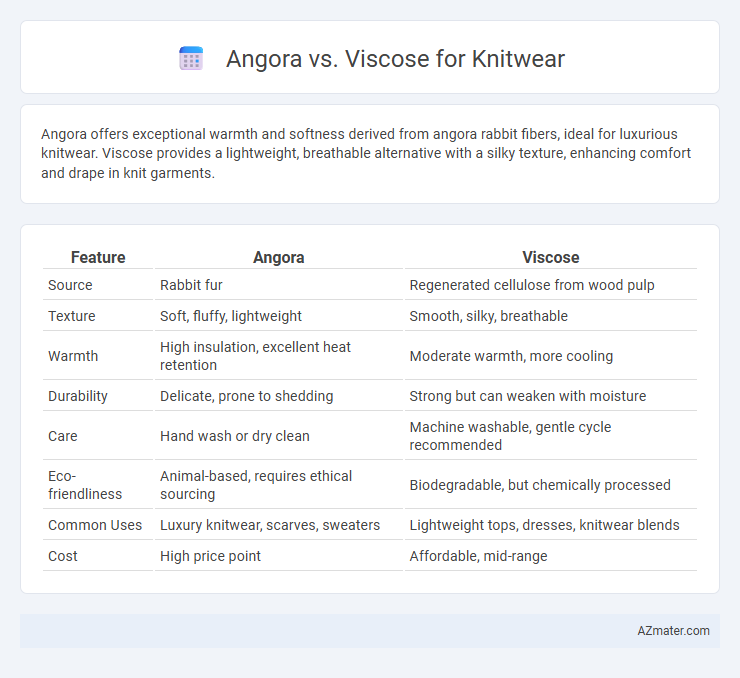Angora offers exceptional warmth and softness derived from angora rabbit fibers, ideal for luxurious knitwear. Viscose provides a lightweight, breathable alternative with a silky texture, enhancing comfort and drape in knit garments.
Table of Comparison
| Feature | Angora | Viscose |
|---|---|---|
| Source | Rabbit fur | Regenerated cellulose from wood pulp |
| Texture | Soft, fluffy, lightweight | Smooth, silky, breathable |
| Warmth | High insulation, excellent heat retention | Moderate warmth, more cooling |
| Durability | Delicate, prone to shedding | Strong but can weaken with moisture |
| Care | Hand wash or dry clean | Machine washable, gentle cycle recommended |
| Eco-friendliness | Animal-based, requires ethical sourcing | Biodegradable, but chemically processed |
| Common Uses | Luxury knitwear, scarves, sweaters | Lightweight tops, dresses, knitwear blends |
| Cost | High price point | Affordable, mid-range |
Introduction to Angora and Viscose
Angora is a luxury fiber derived from the Angora rabbit, prized for its exceptional softness, warmth, and lightweight properties, making it ideal for high-end knitwear. Viscose, a semi-synthetic fiber made from cellulose, offers a smooth texture, breathability, and excellent drape, commonly used as an affordable alternative in knitwear production. Both fibers provide unique benefits: Angora excels in insulation and comfort, while Viscose enhances fabric durability and moisture management.
Origins and Production Processes
Angora fiber originates from the Angora rabbit, primarily produced through careful combing to collect soft, fine hairs, while viscose is a semi-synthetic fiber derived from cellulose extracted from wood pulp, typically beech or eucalyptus trees. Angora requires delicate, labor-intensive harvesting that maintains animal welfare, ensuring the fluffy texture ideal for luxury knitwear; viscose production involves chemical treatment and regeneration of plant fibers to create a breathable, silky textile. The natural origin of Angora contrasts with the industrial scale of viscose manufacturing, impacting sustainability and fabric characteristics in knitwear design.
Fiber Structure and Texture
Angora fiber is derived from Angora rabbits, featuring a fine, hollow core structure that provides exceptional softness, warmth, and a fluffy texture ideal for luxurious knitwear. Viscose, a regenerated cellulose fiber made from wood pulp, has a smooth, continuous filament structure offering a silky feel and excellent drape but lacks the natural insulation properties of Angora. The contrast in fiber morphology results in Angora knitwear being lightweight yet thermally efficient, while Viscose garments emphasize breathability and sheen.
Warmth and Insulation Properties
Angora fibers offer superior warmth and insulation in knitwear due to their fine, hollow structure that traps heat effectively, making them ideal for cold weather garments. Viscose, derived from cellulose, provides a soft and breathable fabric but lacks the natural insulating properties of Angora. Consequently, knitwear made from Angora retains body heat better, while Viscose blends are often used for lighter, cooler garments.
Breathability and Comfort
Angora fiber offers exceptional softness and insulation, making it ideal for knitwear that retains warmth without causing overheating. Viscose, derived from cellulose, provides excellent breathability and moisture-wicking properties, ensuring comfort in more temperate conditions. Combining Angora's warmth with Viscose's breathability can enhance overall comfort and regulate temperature effectively in knitwear garments.
Durability and Longevity
Angora fibers offer exceptional softness but have lower durability, prone to shedding and pilling, which limits longevity in knitwear. Viscose, a semi-synthetic fiber derived from cellulose, provides moderate durability with better resistance to wear and tear, extending the lifespan of garments. Choosing viscose blends can enhance knitwear durability while maintaining comfort, balancing softness and long-term performance.
Sustainability and Environmental Impact
Angora fibers, sourced from Angora rabbits, offer natural biodegradability and renewable qualities but raise animal welfare and resource-intensive farming concerns. Viscose, derived from cellulose in wood pulp, involves energy-heavy chemical processing and deforestation risks, though innovations in eco-friendly closed-loop production systems aim to reduce environmental harm. Choosing sustainably certified Angora or responsibly produced viscose significantly lowers the ecological footprint of knitwear, promoting ethical and environmentally conscious fashion.
Care and Maintenance Requirements
Angora knitwear demands gentle care such as hand washing with cold water and mild detergent to prevent fiber damage and maintain softness. Viscose knitwear requires careful handling to avoid shrinkage, preferably dry cleaning or hand washing, and should be laid flat to dry to preserve shape and texture. Both fabrics benefit from storage in a cool, dry place away from direct sunlight to extend garment longevity.
Price and Market Availability
Angora knitwear typically commands a higher price due to the labor-intensive harvesting process and limited production regions, making it a premium choice in the luxury market. Viscose, produced from cellulose fibers, offers a more affordable and widely available alternative, often found in mass market and fast fashion knitwear collections. Market availability favors viscose, as its synthetic nature allows for large-scale manufacturing and consistent supply, contrasting with the seasonal and geographically constrained sourcing of Angora.
Choosing the Best Fiber for Your Knitwear
Angora offers exceptional softness and warmth, making it ideal for luxurious knitwear that requires a cozy, lightweight feel. Viscose, derived from cellulose fibers, provides breathability, drapes well, and is more affordable, perfect for versatile, easy-care knit garments. Prioritize angora for premium insulation and silky texture, while viscose suits sustainable, breathable knits with vibrant color retention.

Infographic: Angora vs Viscose for Knitwear
 azmater.com
azmater.com